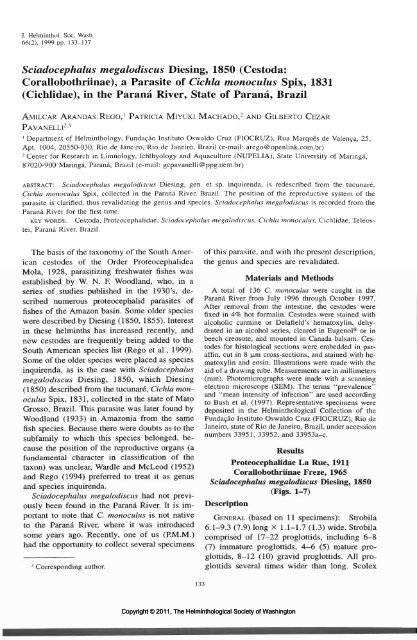The Helminthological Society of Washington - Peru State College
The Helminthological Society of Washington - Peru State College
The Helminthological Society of Washington - Peru State College
Create successful ePaper yourself
Turn your PDF publications into a flip-book with our unique Google optimized e-Paper software.
J. Helminthol. Soc. Wash.<br />
66(2), 1999 pp. 133-137<br />
Sciadocephalus megalodiscus Diesing, 1850 (Cestoda:<br />
Corallobothriinae), a Parasite <strong>of</strong> Cichla monoculus Spix, 1831<br />
(Cichlidae), in the Parana River, <strong>State</strong> <strong>of</strong> Parana, Brazil<br />
AMILCAR ARANDAS REGO,' PATRICIA MIYUKI MACHADO,2 AND GILBERTO CEZAR<br />
PAVANELLI2-3<br />
1 Department <strong>of</strong> Helminthology, Fundacao Institute Oswaldo Cruz (FIOCRUZ), Rua Marques de Valen9a, 25,<br />
Apt. 1004, 20550-030, Rio de Janeiro, Rio de Janeiro, Brazil (e-mail: arego@openlink.com.br)<br />
2 Center for Research in Limnology, Ichthyology and Aquaculture (NUPELIA), <strong>State</strong> University <strong>of</strong> Maringa,<br />
87020-900 Maringa, Parana, Brazil (e-mail: gcpavanelli@ppg.uem.br)<br />
ABSTRACT: Sciadocephalus megalodiscus Diesing, gen. et sp. inquirenda, is redescribed from the tucunare,<br />
Cichla monoculus Spix, collected in the Parana River, Brazil. <strong>The</strong> position <strong>of</strong> the reproductive system <strong>of</strong> the<br />
parasite is clarified, thus revalidating the genus and species. Sciadocephalus megalodiscus is recorded from the<br />
Parana River for the first time.<br />
KEY WORDS: Cestoda, Proteocephalidae, Sciadocephalus megalodiscus, Cichla monoculus, Cichlidae, Teleostei,<br />
Parana River, Brazil.<br />
<strong>The</strong> basis <strong>of</strong> the taxonomy <strong>of</strong> the South American<br />
cestodes <strong>of</strong> the Order Proteocephalidea<br />
Mola, 1928, parasitizing freshwater fishes was<br />
established by W. N. F. Woodland, who, in a<br />
series <strong>of</strong> studies published in the 1930's, described<br />
numerous proteocephalid parasites <strong>of</strong><br />
fishes <strong>of</strong> the Amazon basin. Some older species<br />
were described by Diesing (1850, 1855). Interest<br />
in these helminths has increased recently, and<br />
new cestodes are frequently being added to the<br />
South American species list (Rego et al., 1999).<br />
Some <strong>of</strong> the older species were placed as species<br />
inquirenda, as is the case with Sciadocephalus<br />
megalodiscus Diesing, 1850, which Diesing<br />
(1850) described from the tucunare, Cichla monoculus<br />
Spix, 1831, collected in the state <strong>of</strong> Mato<br />
Grosso, Brazil. This parasite was later found by<br />
Woodland (1933) in Amazonia from the same<br />
fish species. Because there were doubts as to the<br />
subfamily to which this species belonged, because<br />
the position <strong>of</strong> the reproductive organs (a<br />
fundamental character in classification <strong>of</strong> the<br />
taxon) was unclear, Wardle and McLeod (1952)<br />
and Rego (1994) preferred to treat it as genus<br />
and species inquirenda.<br />
Sciadocephalus megalodiscus had not previously<br />
been found in the Parana River. It is important<br />
to note that C. monoculus is not native<br />
to the Parana River, where it was introduced<br />
some years ago. Recently, one <strong>of</strong> us (P.M.M.)<br />
had the opportunity to collect several specimens<br />
1 Corresponding author.<br />
<strong>of</strong> this parasite, and with the present description,<br />
the genus and species are revalidated.<br />
Materials and Methods<br />
A total <strong>of</strong> 136 C. monoculus were caught in the<br />
Parana River from July 1996 through October 1997.<br />
After removal from the intestine, the cestodes were<br />
fixed in 4% hot formalin. Cestodes were stained with<br />
alcoholic carmine or Dclafield's hematoxylin, dehydrated<br />
in an alcohol series, cleared in Eugenol® or in<br />
beech creosote, and mounted in Canada balsam. Cestodes<br />
for histological sections were embedded in paraffin,<br />
cut in 8 (Jim cross-sections, and stained with hematoxylin<br />
and eosin. Illustrations were made with the<br />
aid <strong>of</strong> a drawing tube. Measurements are in millimeters<br />
(mm). Photomicrographs were made with a scanning<br />
electron microscope (SEM). <strong>The</strong> terms "prevalence"<br />
and "mean intensity <strong>of</strong> infection" are used according<br />
to Bush et al. (1997). Representative specimens were<br />
deposited in the <strong>Helminthological</strong> Collection <strong>of</strong> the<br />
Funda?ao Institute Oswaldo Cruz (FIOCRUZ), Rio de<br />
Janeiro, state <strong>of</strong> Rio de Janeiro, Brazil, under accession<br />
numbers 33951, 33952, and 33953a-c.<br />
Results<br />
Proteocephalidae La Rue, 1911<br />
Corallobothriinae Freze, 1965<br />
Sciadocephalus megalodiscus Diesing, 1850<br />
(Figs. 1-7)<br />
Description<br />
GENERAL (based on 11 specimens): Strobila<br />
6.1-9.3 (7.9) long X 1.1-1.7 (1.3) wide. Strobila<br />
comprised <strong>of</strong> 17—22 proglottids, including 6—8<br />
(7) immature proglottids, 4-6 (5) mature proglottids,<br />
8-12 (10) gravid proglottids. All proglottids<br />
several times wider than long. Scolex<br />
133<br />
Copyright © 2011, <strong>The</strong> <strong>Helminthological</strong> <strong>Society</strong> <strong>of</strong> <strong>Washington</strong>
















